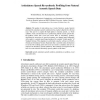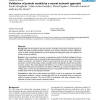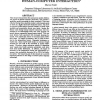48 search results - page 7 / 10 » Seven Habits of Highly Successful Input Modelers |
HAPTICS
2008
IEEE
14 years 1 months ago
2008
IEEE
In this paper we describe a system that combines human input and automatic grasp planning for controlling an artificial hand, with applications in the area of hand neuroprosthetic...
COST
2008
Springer
13 years 9 months ago
2008
Springer
The quality of static phones (e.g. vowels, fricatives, nasals, laterals) generated by articulatory speech synthesizers has reached a high level in the last years. Our goal is to ex...
BMCBI
2008
13 years 7 months ago
2008
Background: The development and improvement of reliable computational methods designed to evaluate the quality of protein models is relevant in the context of protein structure re...
KDD
2006
ACM
14 years 8 months ago
2006
ACM
Collaborative recommender systems are highly vulnerable to attack. Attackers can use automated means to inject a large number of biased profiles into such a system, resulting in r...
NAACL
1994
13 years 8 months ago
1994
This research characterizes the spontaneous spoken disfluencies typical of human-computer interaction, and presents a predictive model accounting for their occurrence. Data were c...



